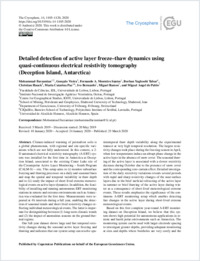Detailed detection of active layer freeze-thaw dynamics using quasi-continuous electrical resistivity tomography (Deception Island, Antarctica)
- Farzamian, Mohammad Faculdade de Ciências, IDL, Universidade de Lisboa, Lisbon, Portugal - Instituto Nacional de Investigação Agrária e Veterinária, Oeiras, Portugal
- Vieira, Gonçalo Centre for Geographical Studies, IGOT, Universidade de Lisboa, Lisbon, Portugal
- Santos, Fernando A. Monteiro Faculdade de Ciências, IDL, Universidade de Lisboa, Lisbon, Portugal
- Tabar, Borhan Yaghoobi School of Mining, Petroleum and Geophysics, Shahrood University of Technology, Shahrood, Iran
- Hauck, Christian Department of Geosciences, University of Fribourg, Fribourg, Switzerland
- Paz, Maria Catarina Faculdade de Ciências, IDL, Universidade de Lisboa, Lisbon, Portugal - CIQuiBio, Barreiro School of Technology, Polytechnic Institute of Setúbal, Lavradio, Portugal
- Bernardo, Ivo Faculdade de Ciências, IDL, Universidade de Lisboa, Lisbon, Portugal
- Ramos, Miguel Universidad de Alcalá de Henares, Alcalá de Henares, Spain
- Pablo, Miguel Angel de Universidad de Alcalá de Henares, Alcalá de Henares, Spain
-
25.03.2020
Published in:
- The Cryosphere. - 2020, vol. 14, no. 3, p. 1105–1120
English
Climate-induced warming of permafrost soils is a global phenomenon, with regional and site-specific variations which are not fully understood. In this context, a 2-D automated electrical resistivity tomography (A-ERT) system was installed for the first time in Antarctica at Deception Island, associated to the existing Crater Lake site of the Circumpolar Active Layer Monitoring – South Program (CALM-S) – site. This setup aims to (i) monitor subsurface freezing and thawing processes on a daily and seasonal basis and map the spatial and temporal variability in thaw depth and to (ii) study the impact of short-lived extreme meteorological events on active layer dynamics. In addition, the feasibility of installing and running autonomous ERT monitoring stations in remote and extreme environments such as Antarctica was evaluated for the first time. Measurements were repeated at 4 h intervals during a full year, enabling the detection of seasonal trends and short-lived resistivity changes reflecting individual meteorological events. The latter is important for distinguishing between (1) long-term climatic trends and (2) the impact of anomalous seasons on the ground thermal regime.Our full-year dataset shows large and fast temporal resistivity changes during the seasonal active layer freezing and thawing and indicates that our system setup can resolve spatiotemporal thaw depth variability along the experimental transect at very high temporal resolution. The largest resistivity changes took place during the freezing season in April, when low temperatures induce an abrupt phase change in the active layer in the absence of snow cover. The seasonal thawing of the active layer is associated with a slower resistivity decrease during October due to the presence of snow cover and the corresponding zero-curtain effect. Detailed investigation of the daily resistivity variations reveals several periods with rapid and sharp resistivity changes of the near-surface layers due to the brief surficial refreezing of the active layer in summer or brief thawing of the active layer during winter as a consequence of short-lived meteorological extreme events. These results emphasize the significance of the continuous A-ERT monitoring setup which enables detecting fast changes in the active layer during short-lived extreme meteorological events.Based on this first complete year-round A-ERT monitoring dataset on Deception Island, we believe that this system shows high potential for autonomous applications in remote and harsh polar environments such as Antarctica. The monitoring system can be used with larger electrode spacing to investigate greater depths, providing adequate monitoring at sites and depths where boreholes are very costly and the ecosystem is very sensitive to invasive techniques. Further applications may be the estimation of ice and water contents through petrophysical models or the calibration and validation of heat transfer models between the active layer and permafrost.
- Faculty
- Faculté des sciences et de médecine
- Department
- Département de Géosciences
- Language
-
- English
- Classification
- Geology
- License
- License undefined
- Identifiers
-
- RERO DOC 328432
- DOI 10.5194/tc-14-1105-2020
- Persistent URL
- https://folia.unifr.ch/unifr/documents/308442
Statistics
Document views: 73
File downloads:
- hau_dda.pdf: 141
